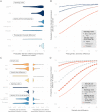Using phylogenetics to infer HIV-1 transmission direction between known transmission pairs
- PMID: 36103580
- PMCID: PMC9499565
- DOI: 10.1073/pnas.2210604119
Using phylogenetics to infer HIV-1 transmission direction between known transmission pairs
Abstract
Inferring the transmission direction between linked individuals living with HIV provides unparalleled power to understand the epidemiology that determines transmission. Phylogenetic ancestral-state reconstruction approaches infer the transmission direction by identifying the individual in whom the most recent common ancestor of the virus populations originated. While these methods vary in accuracy, it is unclear why. To evaluate the performance of phylogenetic ancestral-state reconstruction to determine the transmission direction of HIV-1 infection, we inferred the transmission direction for 112 transmission pairs where transmission direction and detailed additional information were available. We then fit a statistical model to evaluate the extent to which epidemiological, sampling, genetic, and phylogenetic factors influenced the outcome of the inference. Finally, we repeated the analysis under real-life conditions with only routinely available data. We found that whether ancestral-state reconstruction correctly infers the transmission direction depends principally on the phylogeny's topology. For example, under real-life conditions, the probability of identifying the correct transmission direction increases from 32%-when a monophyletic-monophyletic or paraphyletic-polyphyletic tree topology is observed and when the tip closest to the root does not agree with the state at the root-to 93% when a paraphyletic-monophyletic topology is observed and when the tip closest to the root agrees with the root state. Our results suggest that documenting larger differences in relative intrahost diversity increases our confidence in the transmission direction inference of linked pairs for population-level studies of HIV. These findings provide a practical starting point to determine our confidence in transmission direction inference from ancestral-state reconstruction.
Keywords: HIV-1 epidemiology; Lasso regression; ancestral-state reconstruction; phylogenetic tree topology; who acquires infection from whom.
Conflict of interest statement
The authors declare no competing interest.
Figures




References
-
- Rockett R. J., et al. , Revealing COVID-19 transmission in Australia by SARS-CoV-2 genome sequencing and agent-based modeling. Nat. Med. 26, 1398–1404 (2020). - PubMed
Publication types
MeSH terms
Grants and funding
LinkOut - more resources
Full Text Sources
Medical

